AMD Ryzen 5000 Review: The best consumer CPU we've ever seen - lewisyedis1951
Numerous will ensure today as an historic shift in computing power. With its new Ryzen 5000 desktop CPUs, AMD has at length knocked Intel to the shock, and is fostering its boxing gloves in victory As the flash bulbs soda and the ref declares a succeeder. The headline takeaway: Ryzen 9 5900X and Ryzen 9 5950X have trounced Intel's Core i9.
The Ryzen 5000 chips using AMD's Window pane 3 cores are arguably the best consumer screen background CPUs the world has always seen. Ryzen 5000 simply gives nary quarter to its Intel arch-nemesis in any various task. Backbreaking lifting multi-core work? AMD. Light single-rib tasks? AMD. Gaming? AMD. PCIe 4.0? AMD. No want to throw away your existing motherboard? AMD.
The $800 Ryzen 9 5950Xand $550 Ryzen 9 5900Xhave sol utterly destroyed Core i9 that we're still stunned by the severity of the sweep. Simply at the same time, we really shouldn't be surprised, as this has been building ever since AMD first showed disconnected its Zen core in Aug. 2016—fair across the Street from where Intel was ironically wrap up its 20th and final Intel Developer Forum.
In that location's a lot to unpack with these new CPUs, merely we understand if you want to skip to "the good squeeze." Indeed record on if you want to hear about AMD's path to glory over the quondam few years, or flavor slaveless to jump ahead to these upcoming sections:
- Ryzen 5000 Public presentation: How We Proven
- Ryzen 5000 Version Performance
- Ryzen 5000 Self-complacent Creation Performance
- Ryzen 5000 Compression Performance
- Ryzen 5000 Play Performance
- Central processor Threadscaling
- If you ever read the last chapter first: Our Conclusion
Before Ryzen. After Ryzen.
You arse see just how disruptive Ryzen has been by look the table below, which summarizes the last five long time of consumer background computing story. At the top you can see the calm, blue Waters of Intel, whose but competition was itself, testing the limits of just how much IT could charge a consumer for a CPU (Hint: information technology was $1,723).
The first red debut, AMD's creative Ryzen processor, would upend it all by offering an 8-core CPU for less than half of what Intel had been charging the twelvemonth before.
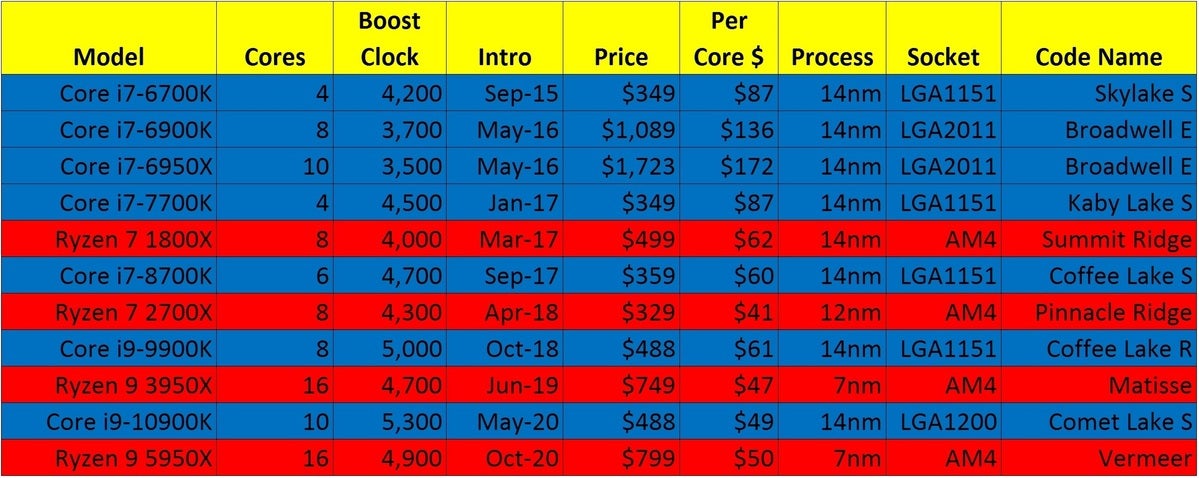 IDG
IDG Earlier Ryzen. And After Ryzen.
From at that place it's just been one duck and wind after another. As Intel's chip architecture languished at 14 nanometers, AMD has literally danced or so its rival's aging body in the ring. AMD goosed its process, slightly improved its performance, so cut prices even further with its Ryzen 7 2700X.
With Ryzen 9 3950X, AMD shocked the world with a consumer Mainframe backpacking 16 cores on a 7nm process at a logical terms. Piece we wear't bear witness it—the Intel equivalent—the Core i9-9960X was slower and cost $1,600.
You tail end see that with all iteration of Acid and Ryzen, AMD has high-backed Intel into a corner. The last few reasons to consider Intel desktop chips were narrow, but they were real: single-threaded performance and gaming performance.
With Ryzen 5000 and Zen 3, AMD lands the final knock-out punch, where you can see the swither and spittle flying off Burden's face in slow motion.
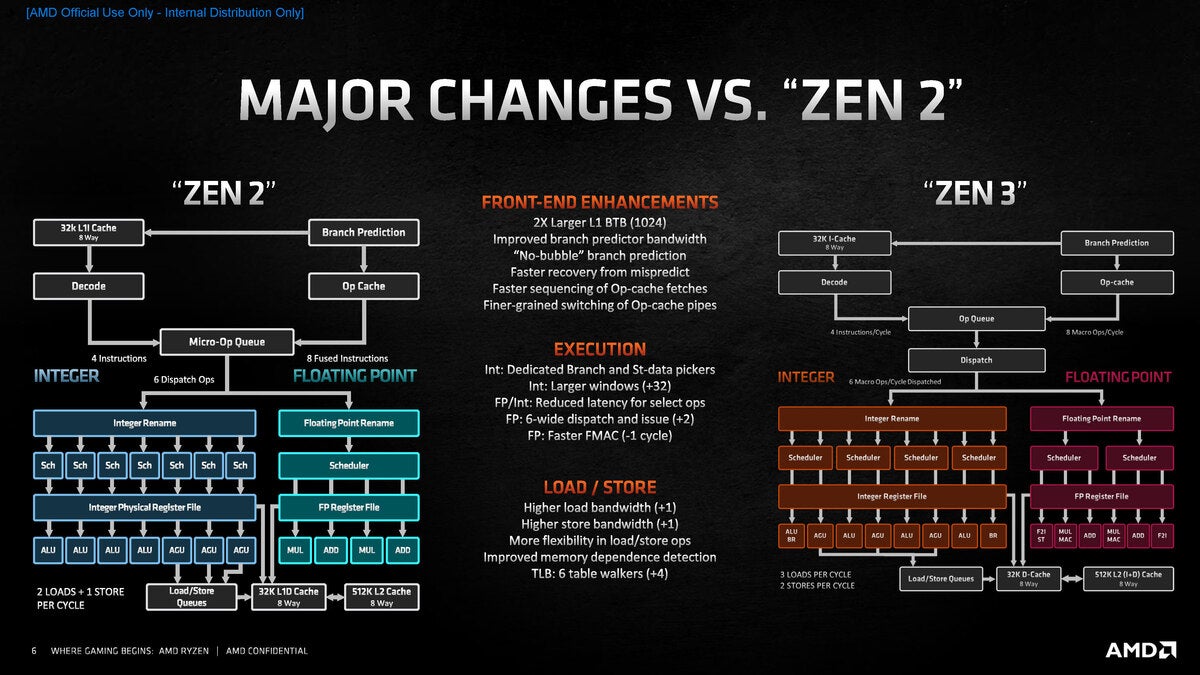 AMD
AMD Perhaps what's crazier about the victories of the previous Ryzen chips is AMD did it without changing much. Dependable, it helped to have TSMC's advanced 7nm process to shrink the sizing of the early Ryzen 3000 serial, but the real core design didn't deepen much.
With Ryzen 5000, AMD says IT initiated a near-establish-risen redesign of the core, with three goals: performance, latency, and power efficiency.
For the cores themselves, AMD improved integer performance, floating point performance, and branch prediction. Response time, however, received one of the biggest upgrades, with a redesign of the core complex (CCX), the basic building block of the chip.
Different Intel which fashions its CPUs from a monolithic slice of silicon, AMD assembles Ryzen from multiple "chiplets." This gives AMD ALIR more than flexibility in yields and construction. Zen 3, e.g., uses the same IO die that contains the PCIe 4.0 lanes and storage controller as Zen 2. This let AMD get its newest cores into existing sockets and motherboards without disturbing everything underneath it.
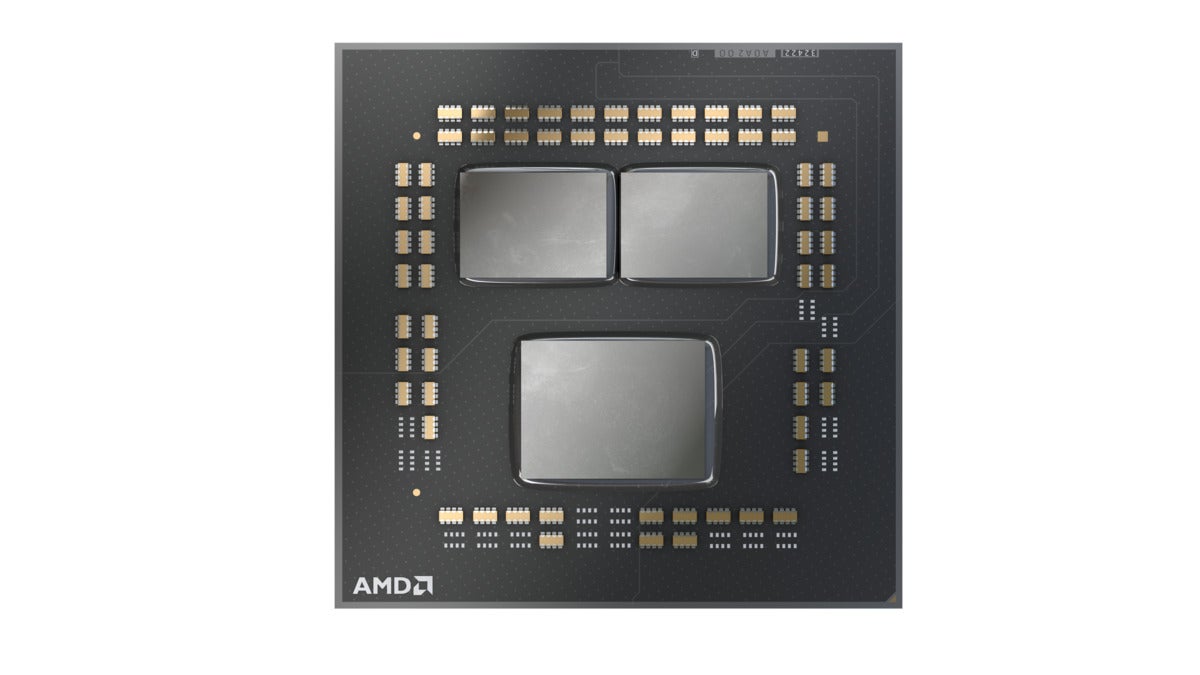 AMD
AMD With previous Ryzen chips, each CCX was constructed of quaternion x86 cores, which were connected to a back CCX to make a core chiplet die (CCD). This design lead to a latency toll when the cores had to transmit outside of the 4-core CCX. AMD said it has measured this latency in a range from 78ns to 95ns. With the coordinated 8-core CCX, the latency is basically eliminated.
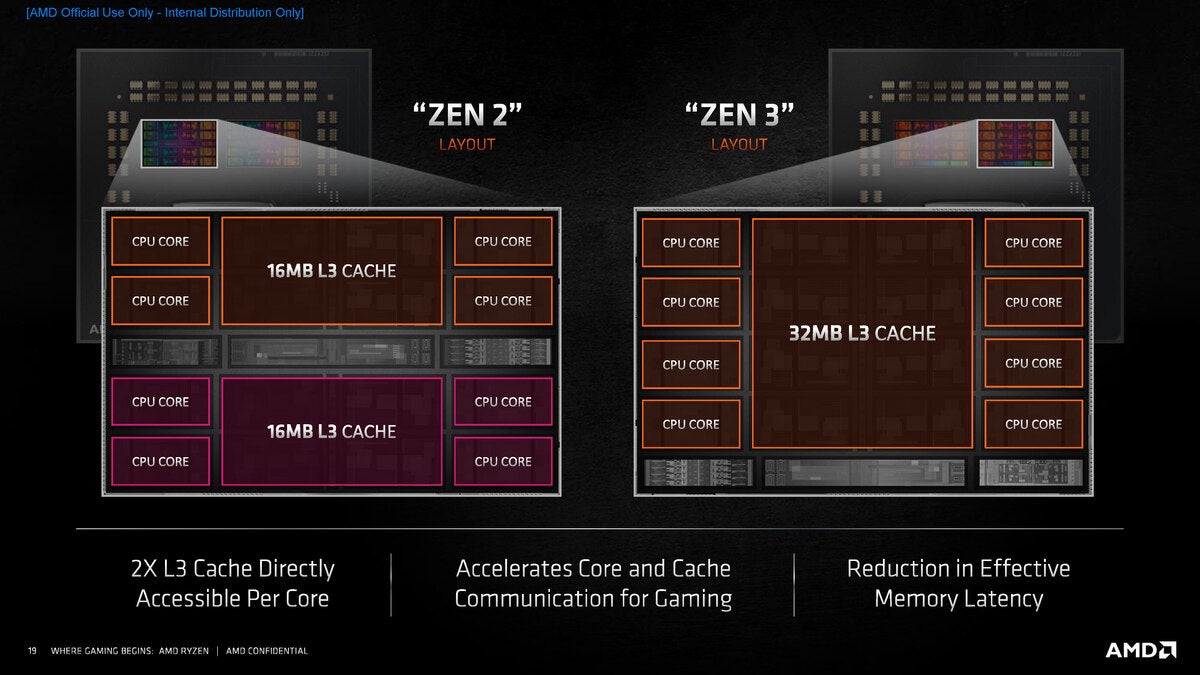 AMD
AMD Some other benefit of the new unified 8-kernel CCX is more available L3 cache. The preceding design gave apiece 4-burden CCX 16MB of L3 memory cache, but IT couldn't be shared. By combine all of the cores into one CCX, each eight now share 32MB of quad.
This savings in latency and increase in cache size is what AMD credits for much of its huge gains in play. In point of fact, AMD engineers said the impact of the humongous L3 on today's games was "center-opening."
The new Zen Buddhism 3 cores also feature more aggressive clock gating that can put a core to sleep when not in use. The time gating helps increase boost clocks of the Ryzen 5000 and too saves power. AMD said a sleeping pith uses no power and generates no heat, which contributes to Ryzen 5000's performance and power efficiency.
The cow chip is so efficient, AMD aforesaid, information technology has recorded a 2.8X improvement over an Intel Core i9-10900K, as well as massive performance gains over the previous 7nm Ryzen 3000 CPUs, without drawing some additional power. While AMD doesn't enunciat, we'd guessing this would also give a flock to a laptop version of the chip.
The latent period improvements and the power savings all promote the final end: Performance. AMD said its goal was an astounding 19 percent improvement in instructions per clock (IPC) which it looks like it has largely achieved.
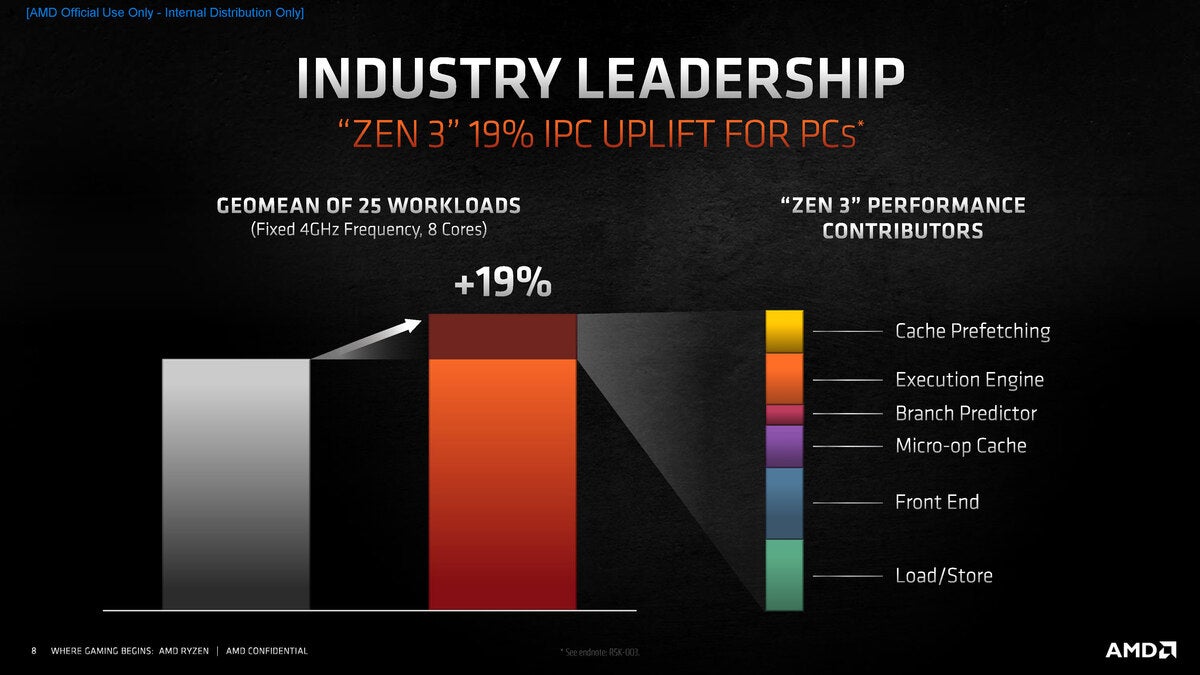 AMD
AMD Ryzen 5000 Performance: How We Tested
Mature Organization Builders strongly cautioned. Some benchmark results may seem inappropriately lopsided for nerds under 13 (pre-teen ages) WHO get never witnessed a benchmark battle this decisive.
For this recapitulation, AMD sampled its top two chips: The 12-core Ryzen 9 5900X and the 16-core Ryzen 9 5950X. For comparisons, we used Intel's newest 10th-gen Center i9-10900K, as well AMD's middle-summer Ryzen 9 3900XT.
The AMD CPUs were tested in an MSI One thousand thousand X570 Godlike motherboard, while the Intel CPU was installed in an Asus Maximus XII Intense board.
Complete four CPUs were tested with the newly-released Windows 10 2H20 adaptation, as advantageously as matching GeForce RTX 2080 Ti GPUs with the latest public driver. Both machines were outfitted with identical 32GB of Corsair DDR4/3600 RAM in plural-convey mode, with their XMP profiles loaded.
For cooling, we used NZXT X62 280mm liquid coolers, with fans and pumps manually set to their maximum speed. Both were built in cases with the case doors off, and small exterior desktop fans blowing line over the motherboard and artwork card.
Repositing along the AMD systems old a Barbary pirate MP600 PCIe 4.0 SSD, while the Intel arrangement used a Samsung 960 Favoring SSD. In a manner, this gives the AMD CPUs an advantage due to PCIe 4.0. On the other hand, AMD is exclusively vendor to offer PCIe 4.0 on a desktop chip today, so it feels unfair to handcuff it to PCI 3.0.
To ensure the results are fair, the vast majority of our tests were retested. For a few tests where the OS, graphics driver are unlikely to move the needle that much, we reused results and noted them per se.
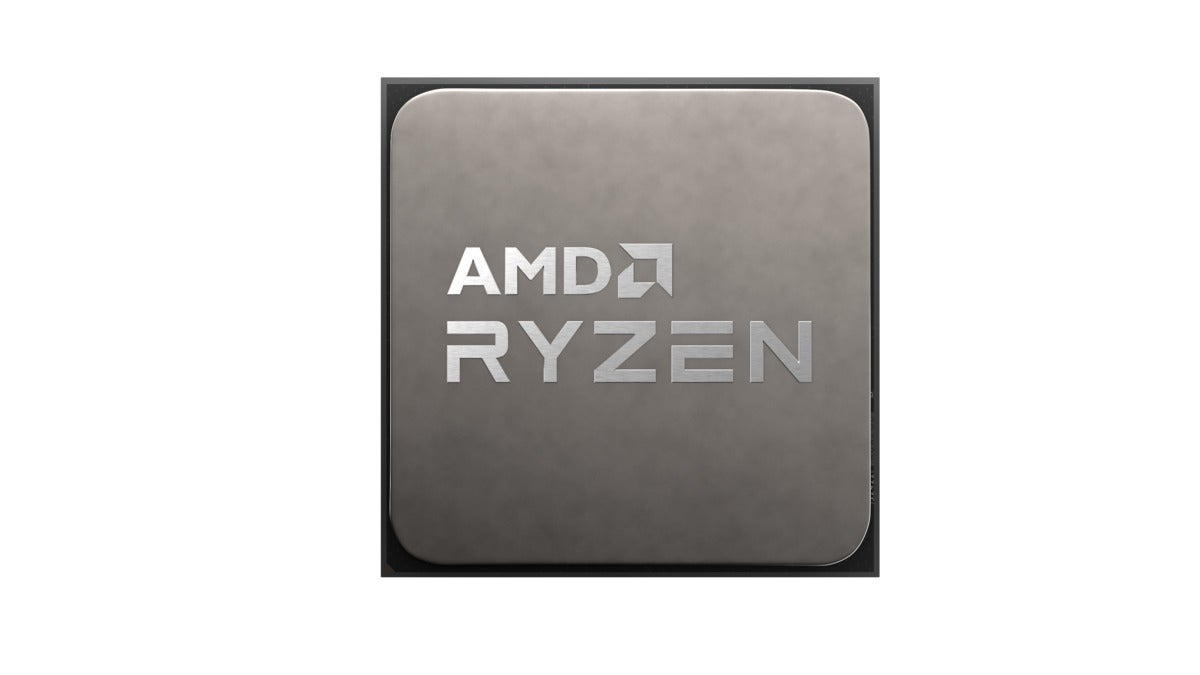 AMD
AMD Ryzen 5000 Rendering Performance
We'll kick this off where we usually act up, with Maxon's Cinebench R20. This is a 3D modelling mental testing based on the same engine Maxon uses in its Cinema4D diligence. Besides being a professional applications programme in use of goods and services every Clarence Shepard Day Jr., it's also the same 3D modelling locomotive engine that's integrated in several Adobe Originative Cloud apps, such As Subsequently Effects and Premiere. Like most 3D modelling apps, it favors more threads and scales with the increment in CPU cores very efficiently.
For this test, we mixing in results from previous reviews. Arsenic Cinebench R20 is nearly a pure Processor test, the results don't move much plane with OS, device driver or BIOS updates. In the graph, the red represents the two rising Zen 3-supported Ryzen 5000 chips, the green represents Zen 2-based Ryzen 3000 chips, and the blue represents various Intel chips.
As a CPU test, Cinebench R20 functioning increases with to a greater extent CPU cores, just holding higher clock speeds matters, as does the actual efficiency of the cores.
On top is the new Ryzen 9 5950X with 16 cores, which offers an awing 14-percent growth in performance over the 16-CORE Ryzen 9 3950X chip. Spell 14 pct is an undreamed of bump, AMD said much of the limitation on all-nub loads is due to the CPU socket power limit. The small-socket AM4 toilet't push the same power like a big-socket Threadripper TRX40 socket.
One step down, the 12-essence Ryzen 9 5900X is less power-restrained, and we see information technology open up an flatbottomed more impressive 17-percent gap over the 12-substance Ryzen 3900XT. Technically, the XT was the best of the best of Lucy in the sky with diamonds 2, and then when you compare the Ryzen 9 5900X against the Ryzen 9 3900X it's actually a 20.7-per centum increase in performance in an all-core load.
Merely No one real cares most red-connected-cherry carrying into action—nerds only want to anger-on-blue. In that location, it's the total stunner you expected. With Intel stuck in the mud at 14nm, the unsurpassed IT keister battleground in a little consumer socket is 10 cores in the Sum i9-10900K. The rightfully "more than high-priced" Ryzen 9 5950X justifies itself with 63 percent more performance. More in its toll browse, the Ryzen 9 5900X outruns the 10-core CORE i9 by 36 percent.
What's take to task-descending, though, is that justified Intel's $980 18-core Cascade Lake-X Heart and soul i9-10980XE gets crushed by the 16-center Ryzen 9 5950X, past 19 percent. Perhaps even more embarrassing, information technology's really only close to 1 pct faster than the $550 Ryzen 9 5900X. And yes, the 12-nitty-gritty Ryzen 9 5900X is within 5 percent of the public presentation of a 16-nitty-gritty Ryzen 9 3950X.
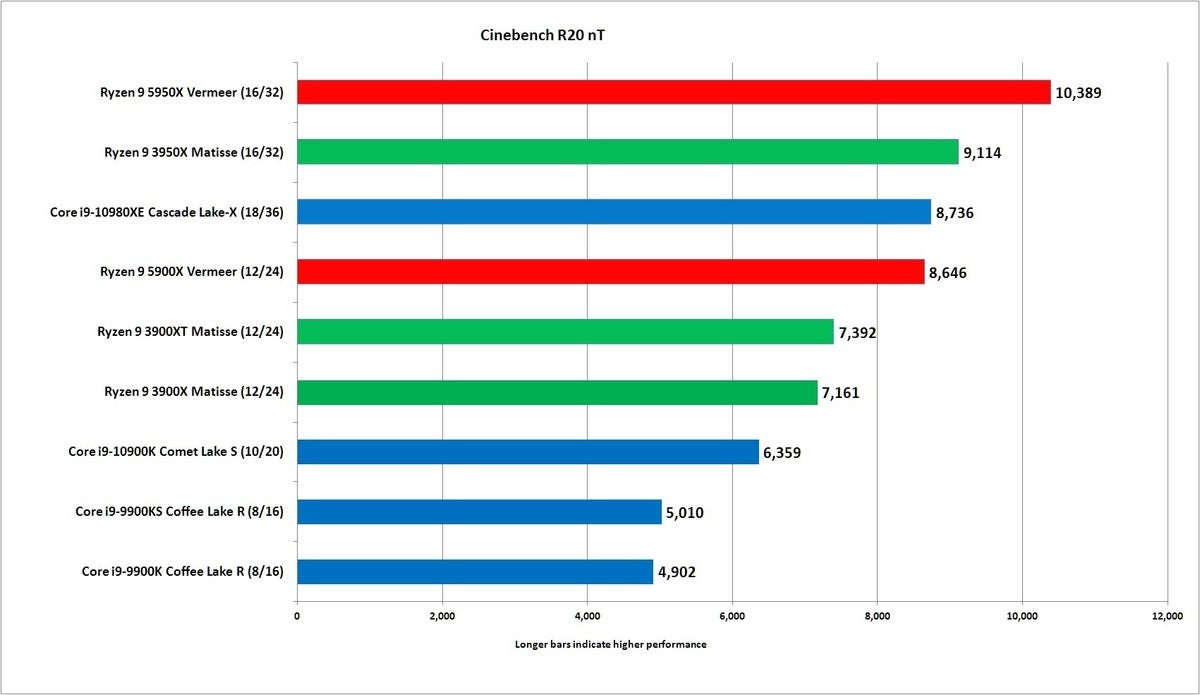 IDG
IDG Ane matter to keep up in nou is Cinebench R20 uses AVX as well as AVX512. Happening Intel's sr. 14nm chips, using AVX operating room AVX512 increases the thermal load, so Intel intentionally lowers the clock speed to manage the heat. Not every rendering engines use these advanced instructions. The Chaos Group's Corona renderer (at to the lowest degree not in the electric current benchmark version), for example, doesn't use AVX or AVX512, so you can find the performance of the Intel chips when they don't have to shift down.
The 18-gist Core i9-10980XE opens up a lead over the 16-core Ryzen 9 3950X and the 12-core Ryzen 9 5900X by active 10 percent. That doesn't matter much though, because the 16-core Ryzen 9 5950X is here to remind Intel who is in bursting charge by outpacing the $900 Core i9 by 14 percent scorn deliver two less Central processor cores. And yes, the 10-core Core i9-10900K easily gets crushed by the 12-core Ryzen 9 5900X, by 36 percent.
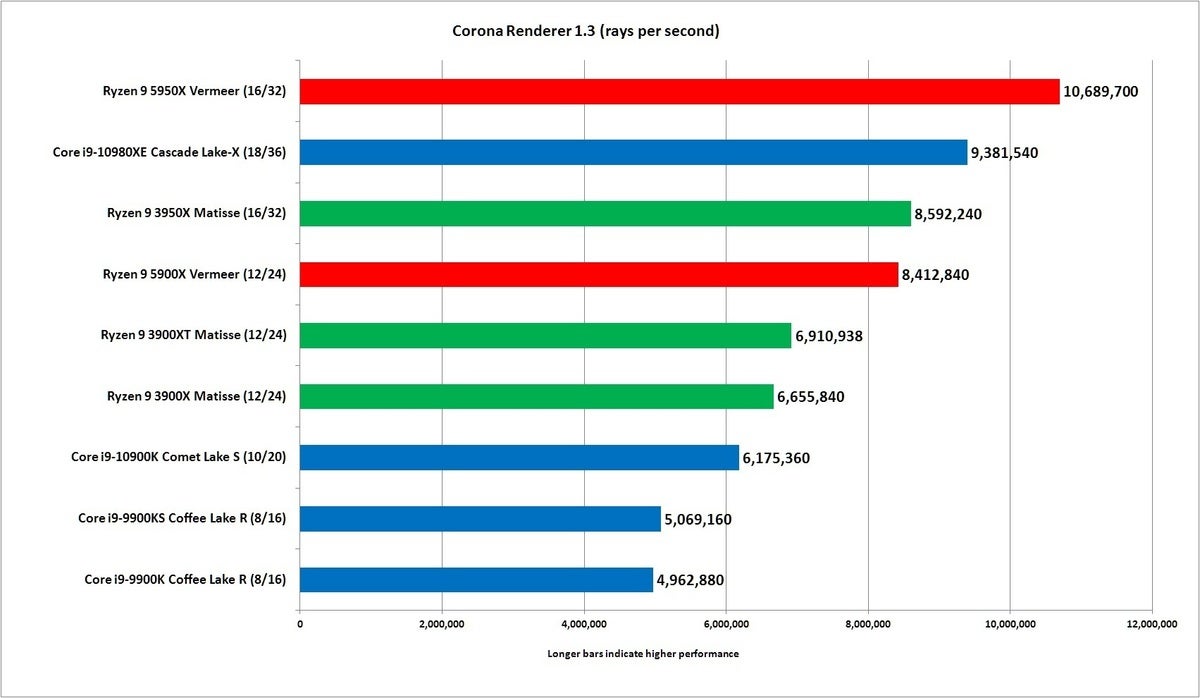 IDG
IDG Our next multi-meat examination uses V-Ray Next to mensuration CPU performance using an Academy Award-winning rendering engine. The results again should surprise none one: The 16-core Ryzen 9 5950X comfortably sits before of the 18-core Intel CPU, and the 12-core Ryzen 9 5900X comes impressively walk-to to the older 16-core Ryzen 9 3950X. The Ryzen 9 5900X once more destroys the 10-core Intel chip by an astounding 42 percent.
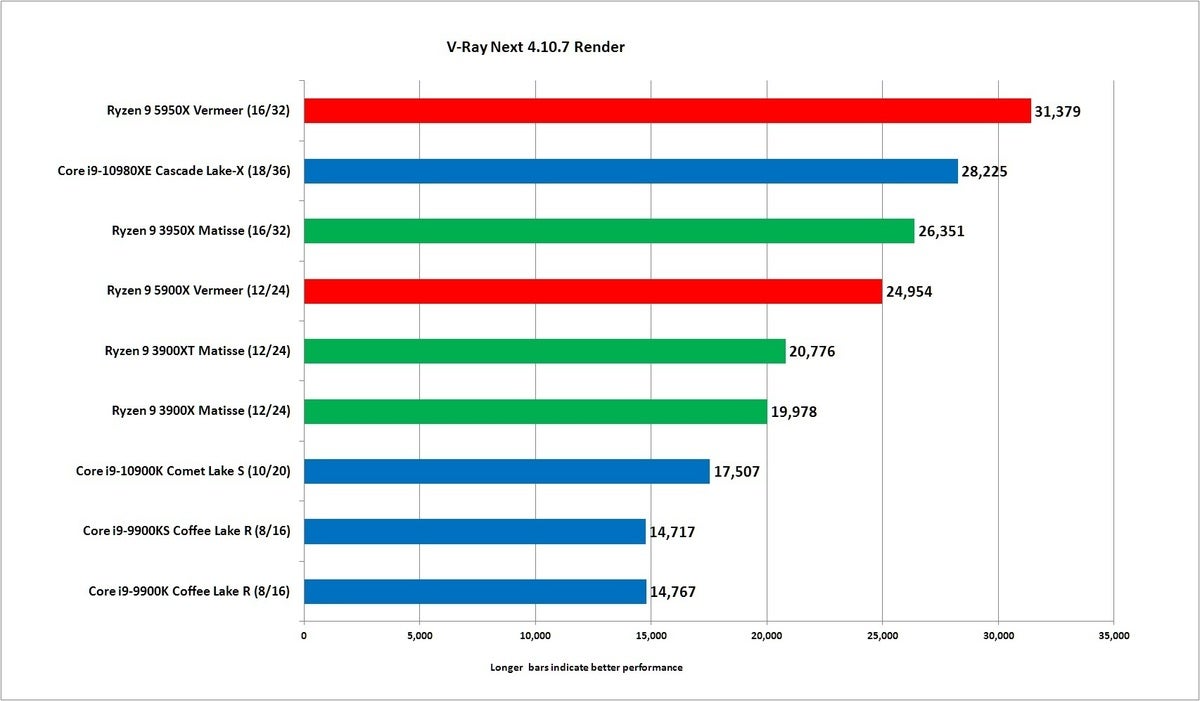 IDG
IDG Our last multi-core modeling test is the Persistence of Vision Raytracer, which dates all the way back to the Amiga. It's been updated since and so past a global team of volunteers. Ilk most 3D modelling programs, it scales dormy in performance with core matter.
While we include historical scores in some other tests, we lonesome include the most current results with POV Ray. We did this non because we think POV Ray requires special treatment, simply because the results are very consistent. The 18-core Core i9-10980XE doesn't fall out on top, nor does the 10-center Core i9-10900K. If individual found a multi-core rendering examine where Intel came dead on top over Ryzen, it would be actual news.
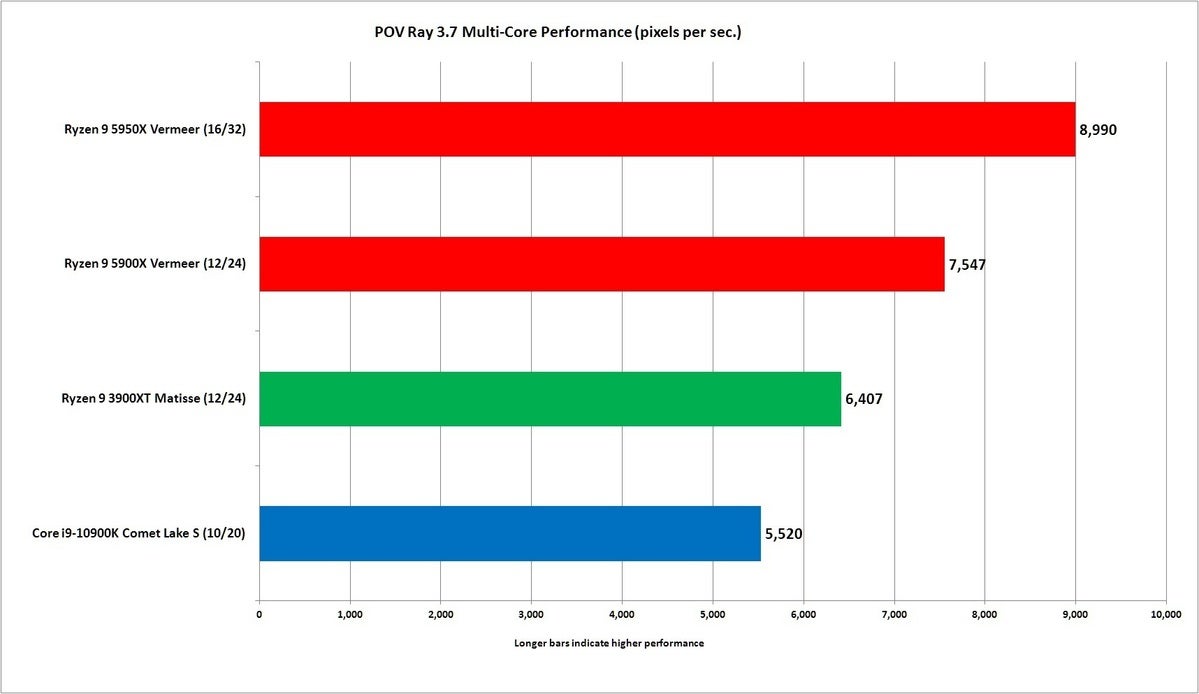 IDG
IDG Information technology's not curious to find Ryzen hammering Heart in multi-core benchmarks, but e'er since the Zen 2-based Ryzen 3000 line, Intel has clung by its fingernails to its lead in single-rib performance. With the Zen 3-based Ryzen 5000, Core i9's slenderize lead finally loses its tenuous clench.
You can see that below: The same Core i9-10900K that's 6.6 percent quicker than the Ryzen 9 3900XT is 14.5 percent slower than Ryzen 9 5900X, and 16 per centum slower than Ryzen 9 5950XT.
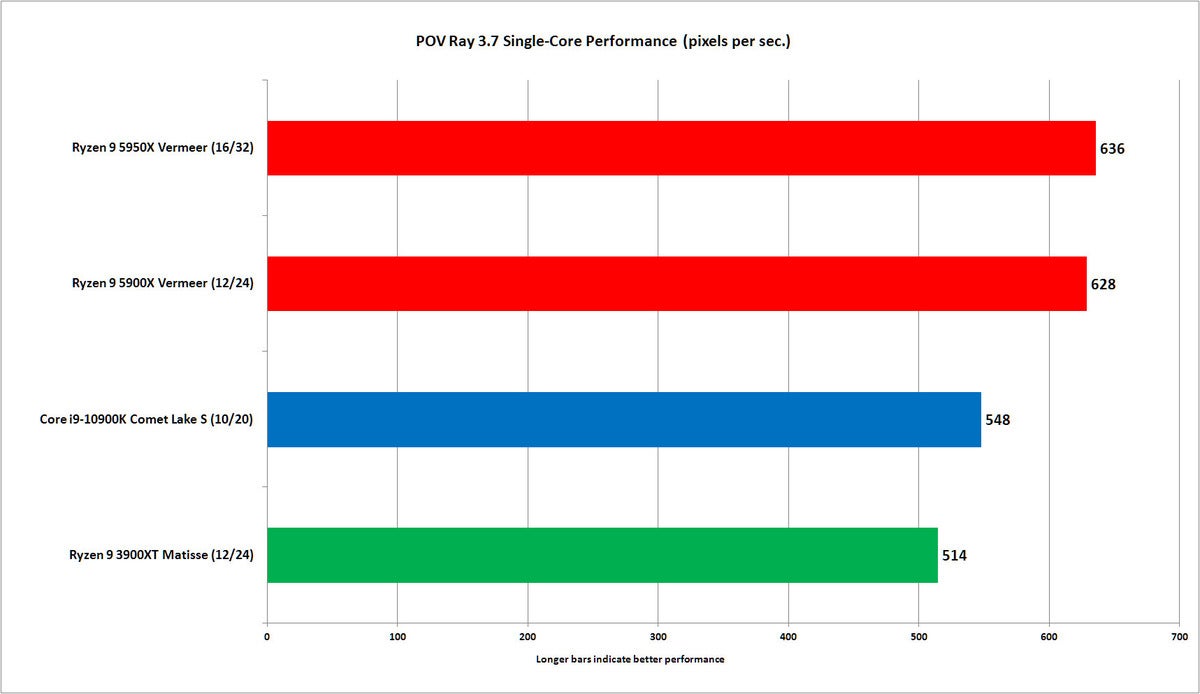 IDG
IDG You can see this over again in Cinebench R20, where the 10th-gen Core i9-10900K is essentially inside the margin of error with the Ryzen 9 3900XT, and about 7 percent faster than the Ryzen 9 3900X. The Ryzen 9 5900X, however, is an idiotic 18.4 percent quicker than the Core i9. The slightly faster Ryzen 9 5950X delivers a solid 20.7-per centum performance advantage over Core i9-10900K.
We'll see how this manifests itself in gaming, where single-threaded execution still matters, just we can't overstate this enough: This is only a stunning turn of events. AMD wipes out the only unexpended justification to buy an Intel desktop CPU today.
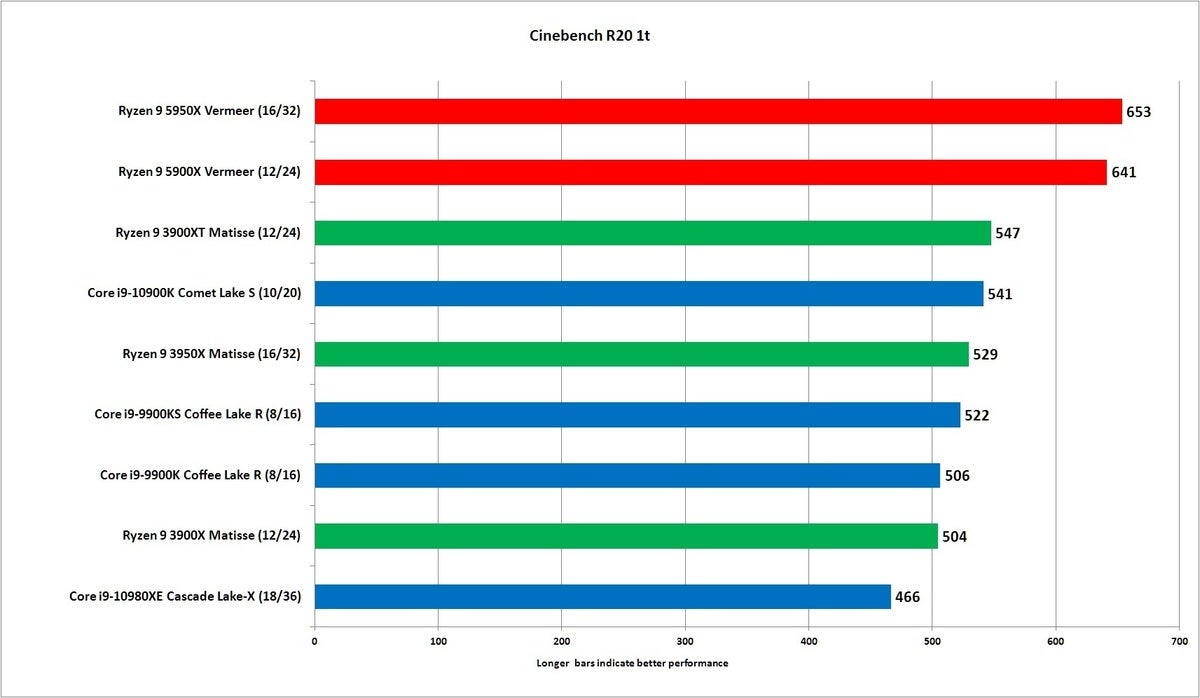 IDG
IDG Ryzen 5000 Content Creation Performance
Content creation is an activity where multi-core CPUs can shine. First up, we'll look at an encryption task using the latest version of HandBrake (version 1.3.3) to transcode the exposed-source Weeping of Steel UHD 4K video recording to H.265/HEVC using the 1080p/30-FPS preset. HandBrake is an excellent encoder and does favour more cores and higher clock speeds, A well equally some special instructions the CPUs offer.
Core counts to a higher place 16 incline to yield diminishing returns, but bolt down Hera with "antimonopoly" 16 cores and below, core counts matter. The 12-inwardness Ryzen 9 5900X decreases encode times over the 12-core Ryzen 9 3900XT away 20.7 percent. That's stupefying as hell, and pretty some AMD's promise of 20-percent improvement over its previous design.
What about Intel? The new Ryzen 9 5900XT encodes take about 29 percent less time, with only about 20 percent Thomas More togs. The 16-essence Ryzen 9 5950X decreases the encode time by 39 percentage, which once more is a very decent return founded on having 60 percent much threads.
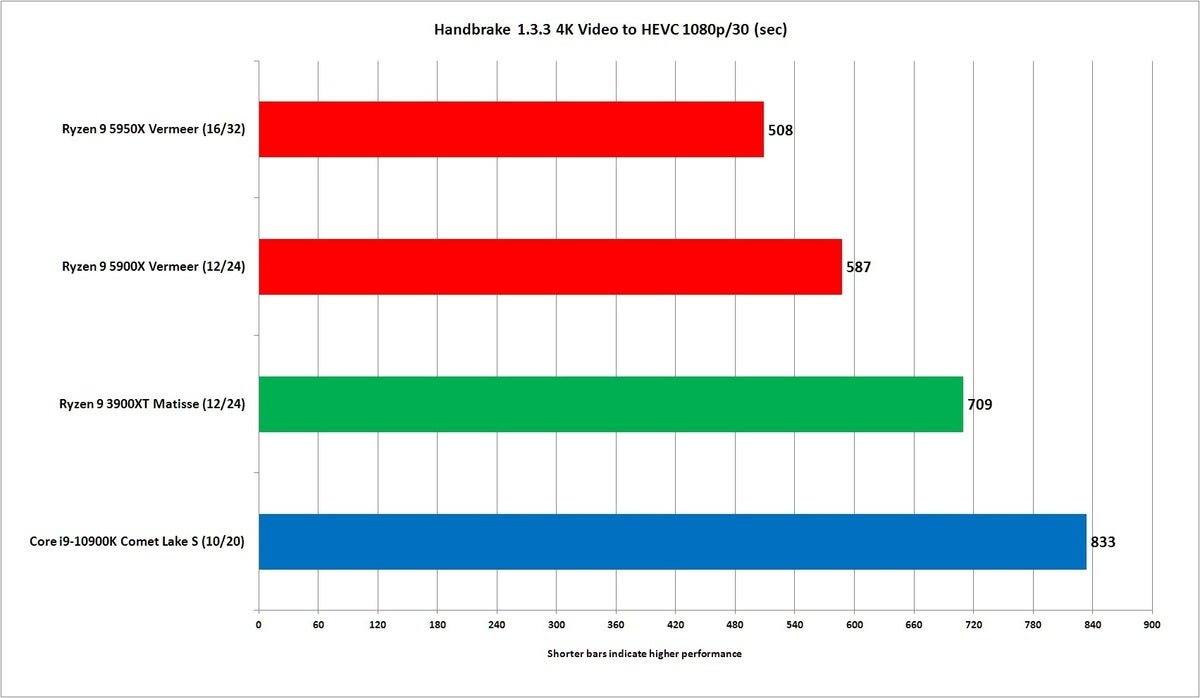 IDG
IDG While HandBrake is a free and popular encoder, we also wanted to look after at tasks powerful CPUs get used for: video redaction and photo editing. For that we use the latest adaptation of Adobe Original Cloud Premiere Pro and run the CPUs through workstation builder Puget System's benchmark tests. It breaks the test into versatile GPU-leaden and CPU-gravid tasks using MultiCam modes, as well A various popular professional codecs. When information technology's done, the benchmark produces a score. For our tests, we ran the standard test run.
Premiere, we'll level KO'd the result 'tween the 12-core Ryzen 9 3900XT and the 10-core Core i9-10900K chip. Despite its lower core count, the Core i9 actually edges out the Ryzen 9 3900XT by about 4 pct. Settled on that, Intel has the reward–barely.
The 12-heart Ryzen 9 5900X, however, opens up a material gap to the tune up of 13 percent. Ryzen 9 5950X is slightly faster at 14.3 percent.
Both scores are solid wins, and a clear advantage for Ryzen 5000, only it's non the yield you'd control with 3D moulding tasks. Still, if the cost is similar or close, we'd take the Ryzen 5000, and that's all that matters to AMD.
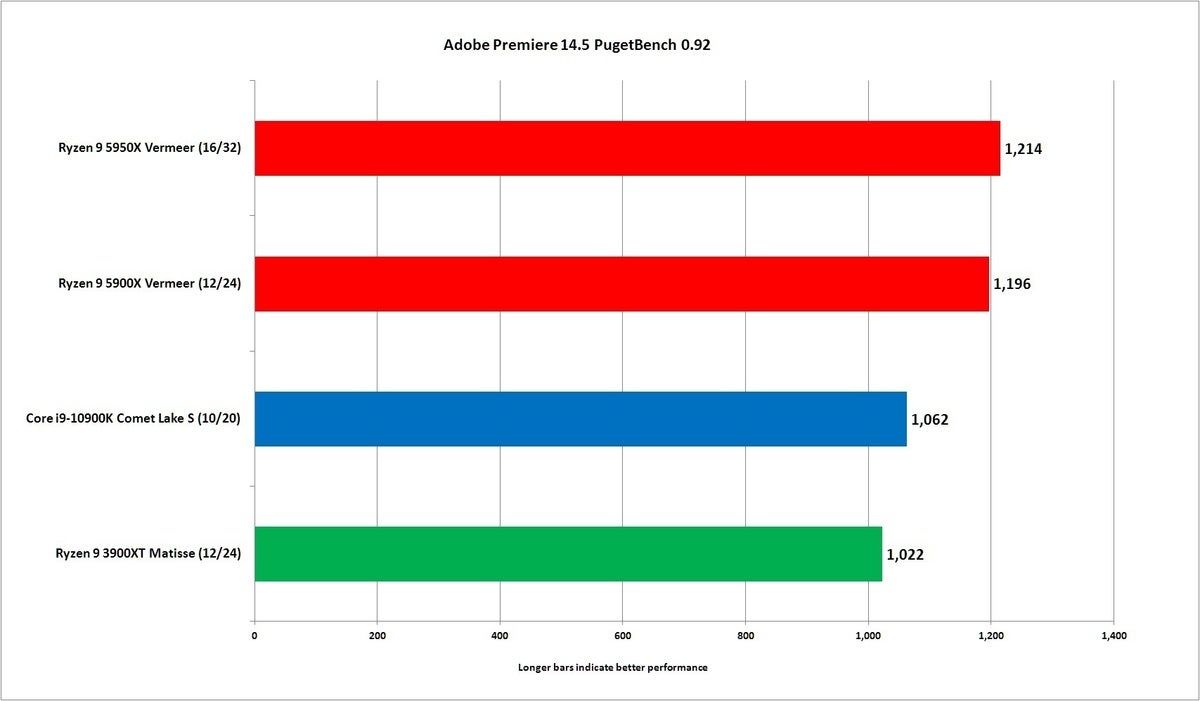 IDG
IDG Ryzen 5000 Compression Performance
Next we move on to compression tests using the popular 7-Zip app. The first result is 7-Aught 19.00's performance compression mental testing. The compression pull is sensitive to memory response time, cache performance and out of order execution. The result is no surprise.
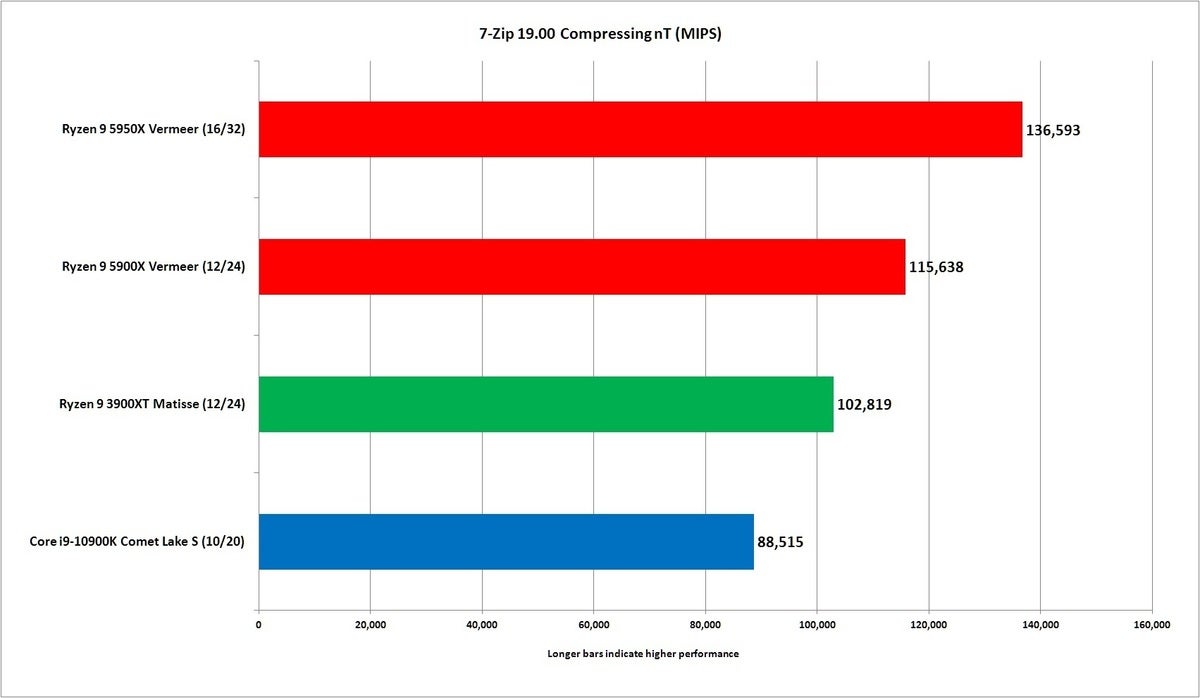 IDG
IDG Decompressing performance is highly sensitive to integer carrying into action, and outgrowth prognostication carrying into action. With this test less reliable along retentivity rotational latency and memory bandwidth per core, we again interpret that more cores matter. The 16-core Ryzen 9 5950X opens up a huge lead ended the 12-gist Zen 3 chip.
 IDG
IDG We'll block off our 7-Zip part with idiosyncratic-threaded results, which party favour AMD's chips again. We don't motivation to show you the decompress single-threaded functioning, because it's the same, with AMD running over Intel.
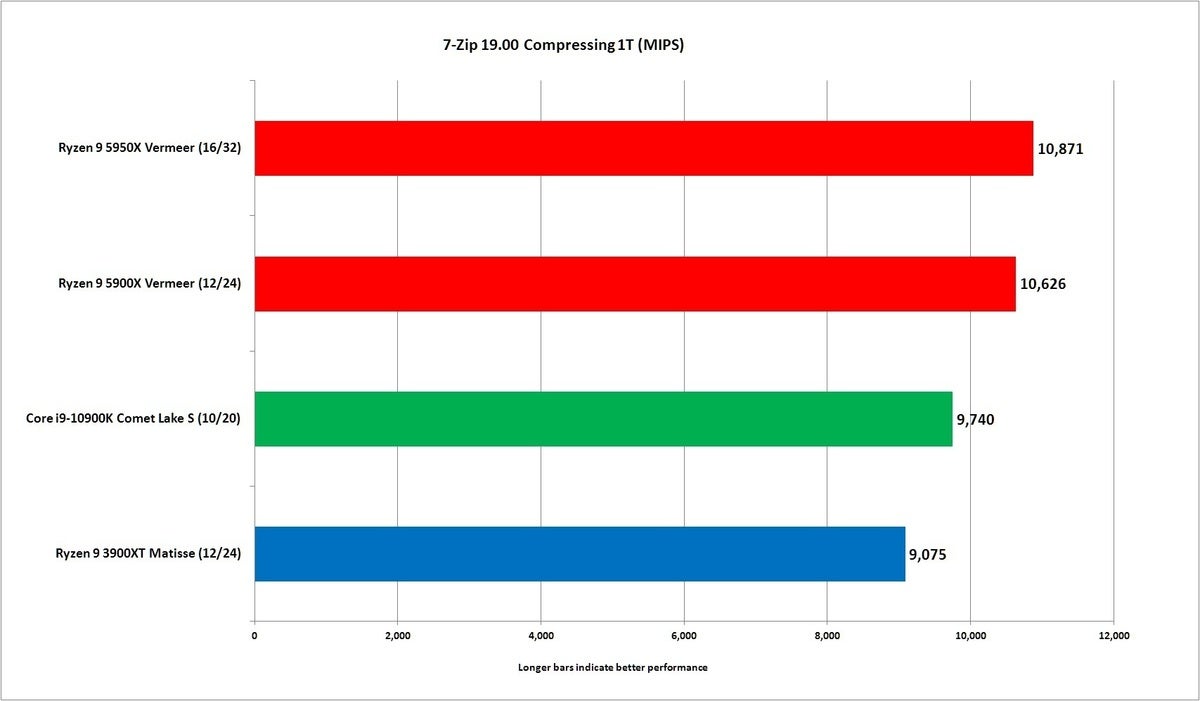 IDG
IDG So far nothing—nothing—has put the Intel Core i9 in nominal head of the Zen 3 chips. Nevertheless, we were dumbstricken when the Intel chip bemused WinRAR's built-in benchmark victimisation complete of the cores. The test itself doesn't use all single thread, but it has long run dreadfully connected AMD CPUs–the 10-core Core i9 has a 15 percent advantage over the 12-core Ryzen 9 3900XT.
Our pet theory is that this particular test runs poorly on CPUs with increased latency. We say that because we proverb Intel's performance suffer when IT went from the ringbus design of the original 10-core Core i7-6950X to ensnarl-based Skylake-X. Zen 3's greatly reduced response time should therefore help, merely the results didn't map utterly to our theory. The 16-core Ryzen 9 5950X is actually underperforming the 12-core Ryzen 9 5900X by a large amount despite the additional cores. Both chips are also constructed with plural-come off CCDs, so the jury remains out. We should also note that spell WinRAR supports multi-substance, it doesn't scale to the 24 or 32 threads of the Ryzens—operating theatre even the 20 threads of the Substance i9.
There's more to search here patently, but Ryzen still wins, in a psychometric test we've never, ever seen it win at when put against Intel.
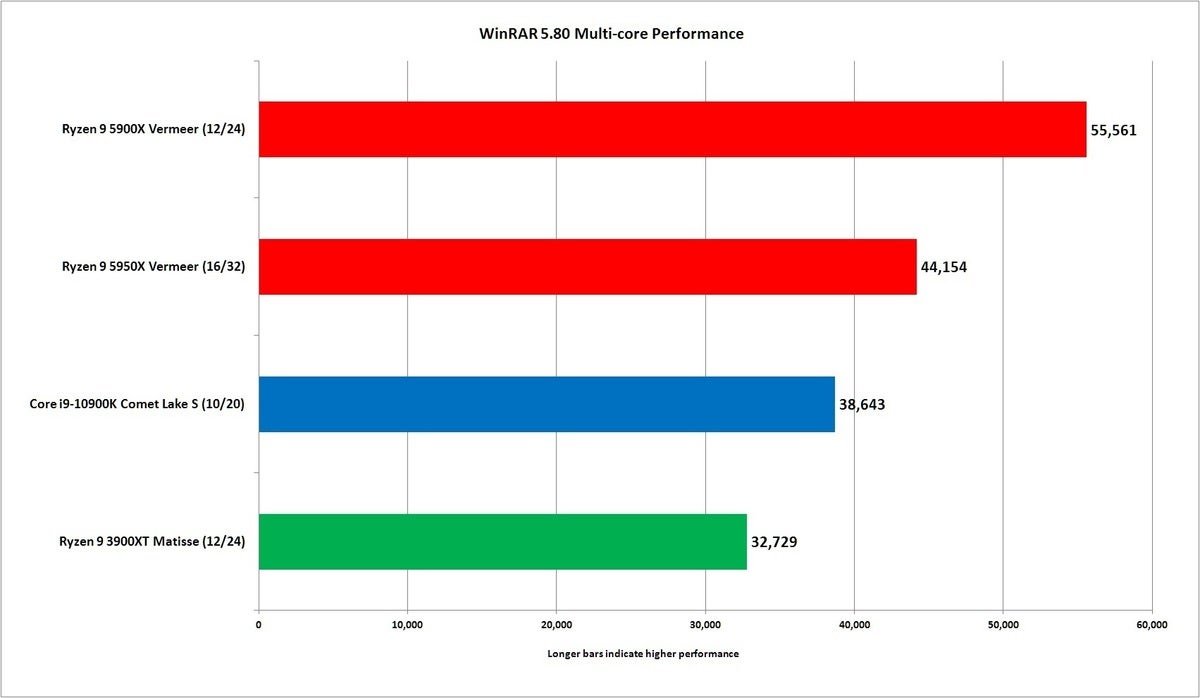 IDG
IDG WinRAR single-threaded performance helps murder those pesky questions of latency crosswise cores or CCDs, but the result is the same. Patc the Core i9 has a 12-percentage lead finished the Ryzen 9 3900XT, the Ryzen 9 5900X comes in an astounding 71 percent faster than the Intel silicon chip. The high-clocked Ryzen 9 5950X is slightly quicker every bit well.
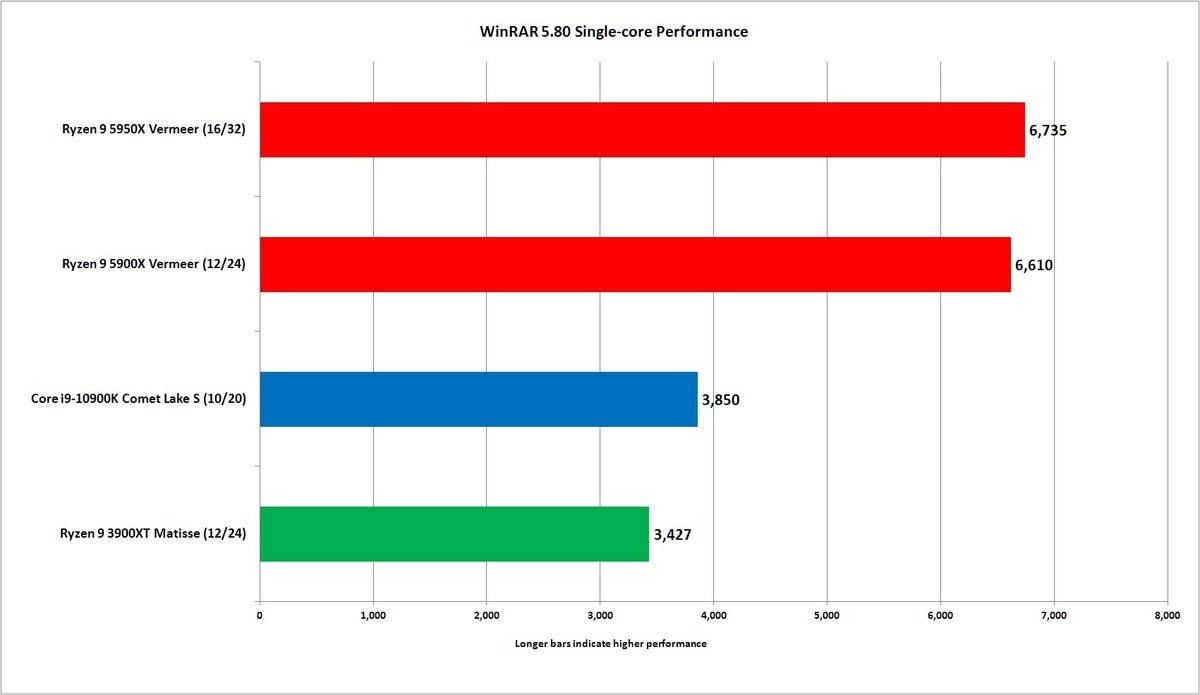 IDG
IDG Ryzen 5000 Play Performance
So you already knew that AMD rules the day in multi-kernel performance, and you today know it gives Intel no quarter in single-core either. The peerless field that's made potential drop customers uneasy is gaming performance. Even though Intel years past ceded multi-core performance, it's still been able to say truthfully: "Core i9 is best for gambling." There's obviously a lot of nuance to that instruction, but we've generally agreed that when matched with the fastest GPU and a high-freshen up plac impanel—Sum i9 is indeed the better play CPU.
Until nowadays. Although the wins aren't as unquiet everywhere else, we do think thither is a clear grammatical case for AMD's claims that the Zen 3-based Ryzen chips are the "foremost gambling CPUs."
For our gaming section we tested at 1920×1080 resolution, with some PC's outfitted with Nvidia Founders Edition GeForce RTX 2080 Ti cards using the same drivers. Unlike the past tests, where we sorted the results by winner, we kept all of our gaming charts ordered aside: Ryzen 9 3900XT, Ryzen 9 5900X, Ryzen 9 5900X, and Core i9-10900K. We exclude previous results, because graphics drivers and game updates make it unfair to compare.
First we'll kick information technology off with Deus Ex: Mankind Divided set to High. If you look at the chart and pretend not to see the newest AMD CPUs in red, you'll see the familiar result that Intel has hourlong had in play. With this game set to High pressure kinda than Radical, the test becomes less GPU-bound, and you see that representative 20-pct performance vantage that Intel CPUs have long enjoyed over AMD CPUs.
Now on that point's Ryzen 5000, where we witness both Dot 3 chips essentially within the margin of error. While we're really "only" talking active a 2- to 3-percent operation difference between the Ryzen 9 and Core i9, IT's Former Armed Forces better than the habitual 10- to 20-per centum performance hollow Ryzen has fallen into before in non-GPU-limited tasks.
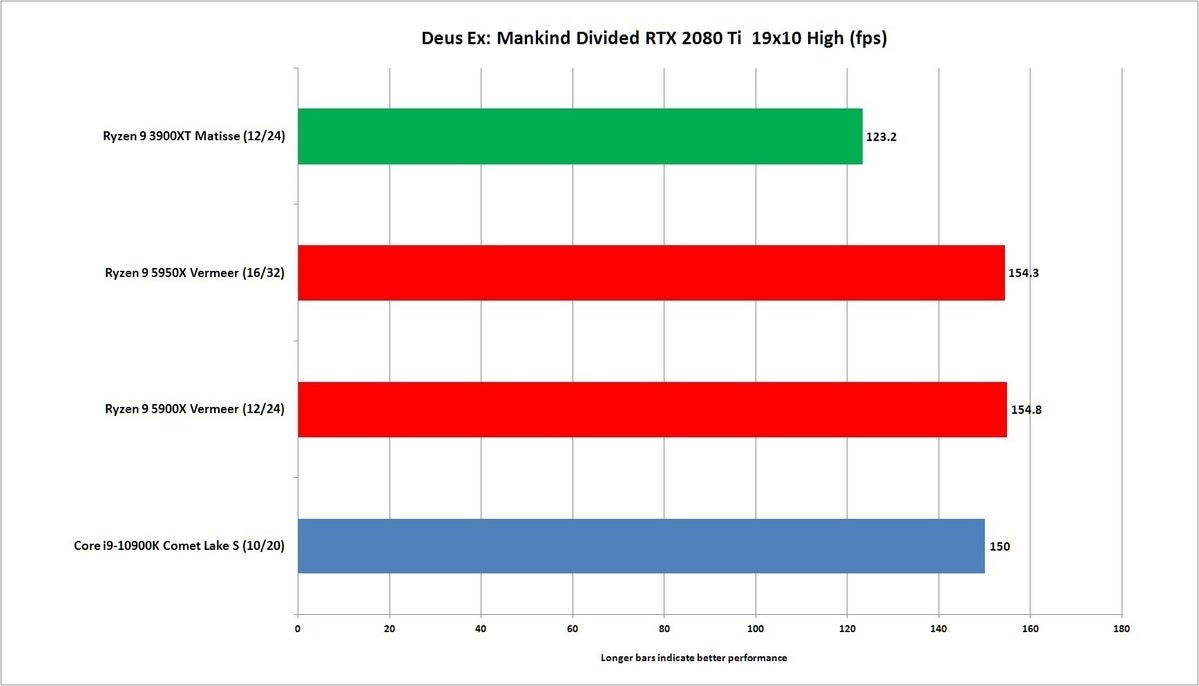 IDG
IDG The results in Deus Ex aren't just a fluke. We also power saw both Ryzen 9 CPUs edge the Core i9 in Former Armed Forces Shout out New Dawning. We're again talking maybe 4- to 5-percent advantage, merely when you look at the 14-percent hole the Ryzen 9 3900XT is in, it's a clear bring home the bacon for AMD.
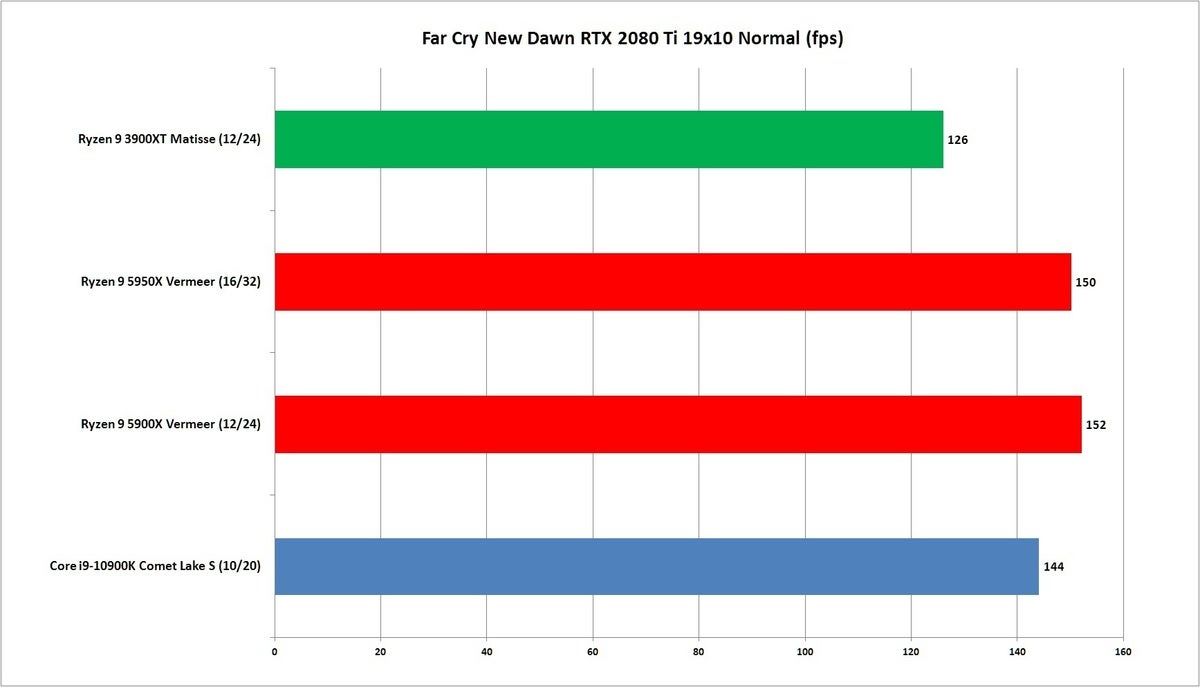 IDG
IDG Not all games favor Intel, either. Our result in Red Unprofitable Salvation perplexed the States so much, we had to rerun it on the Intel machine and the Ryzen 3900XT to make for sure we didn't goof it upwards. Yes, the mighty Core i9 loses to both the older Zen 2 and the new Zen 3 chips—all of which we suspect to be GPU-special. This, however, is the outlier. Typically in games where it isn't limited aside the by the GPU, Nitty-gritty i9 has been faster, so it's a surprise to realise Ryzen 3000 jump in front present. Ryzen 5000, however, is mighty where we expected it to be: in front line of Core i9.
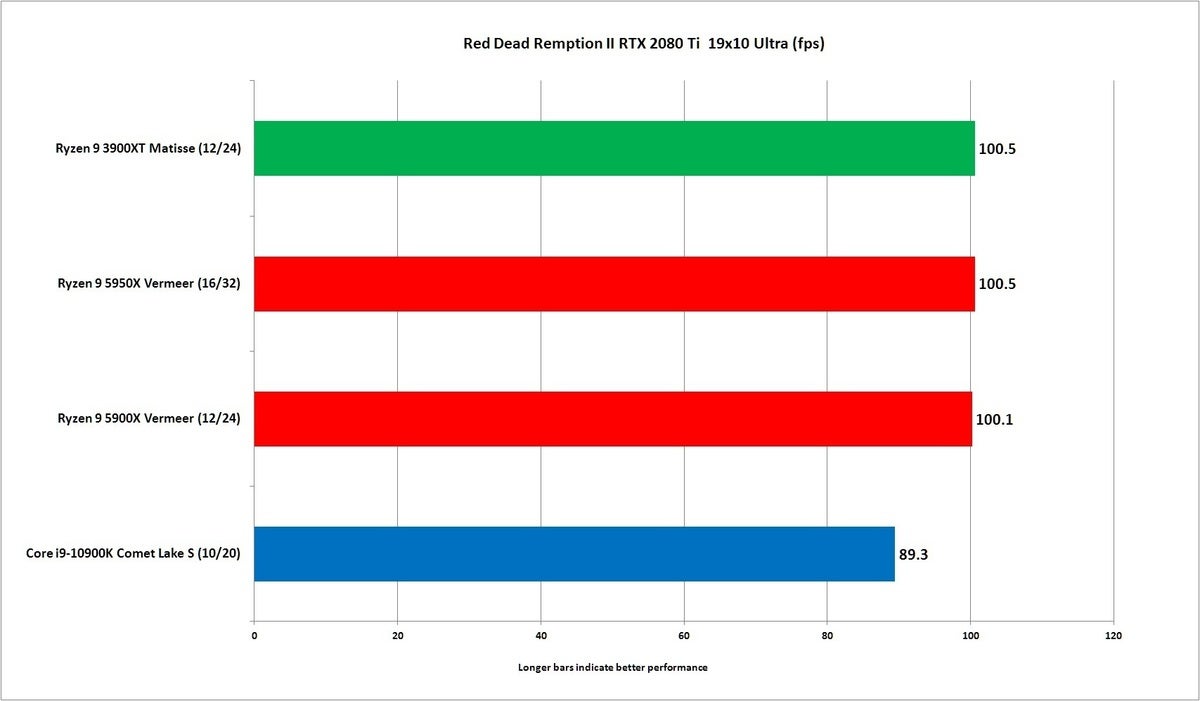 IDG
IDG You ass once more see that in the popular simply graphically highCounter Strike: Circular Operations, where the Effect i9 has a 9-percent advantage o'er the senior Ryzen 9 3900XT. The Elvis 3 Ryzen 9's adjoin out the Core i9 by about 2 to 3 percent.
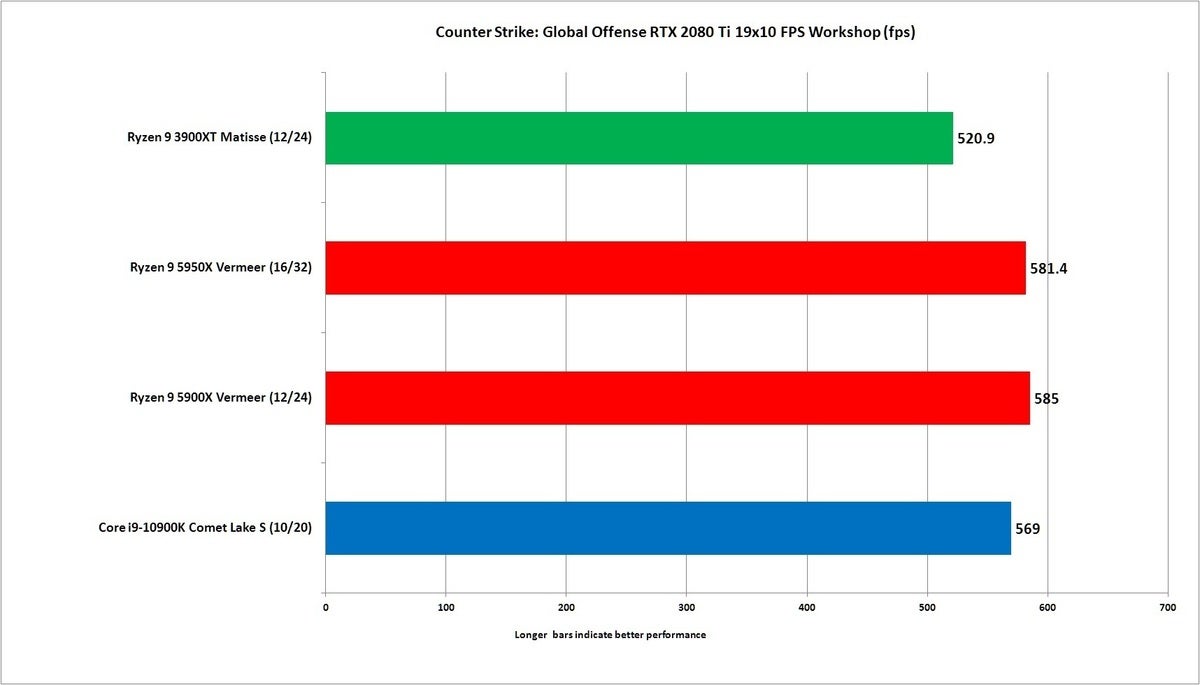 IDG
IDG We've combined most of our gamey results into a single chart that's color-coded with green for Zen 2, red for the two Zen Buddhism 3 CPUs, and blue for the Core i9. It's not a total win in every family, but generally, the new Ryzen 5000 chips sustain a tenuous advantage over the Intel Core i9.
A few notes about the results: In Civ 6 Assemblage Storm, we victimised the Three-toed sloth bench mark to determine which CPU is faster making decisions, and a lower score is better. In Gears of War 5, the bet on refused to run on our Intel Core i9 even after uninstalling the spunky and reinstalling it. You can still see that the new Ryzen 9s have a very decently performance improvement over the older Ryzen 9.
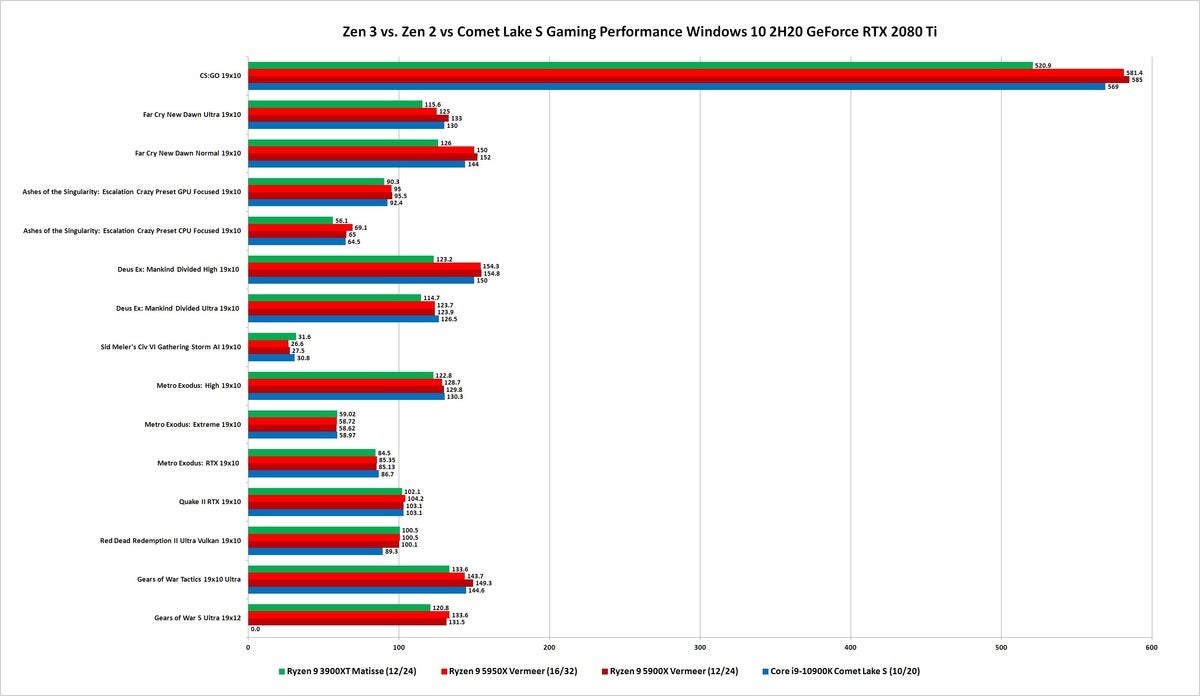 IDG
IDG And yes, thither are many tests here that we suspect would run faster connected the Ryzen 9 if we but had a quicker GPU. That in itself is insane, because our card is the $1,200 GeForce RTX 2080 Te, but there are definitely faster graphics cards out today—we exactly didn't have access to some for our examination.
If it doesn't appear corresponding a plumping deal to be basically slightly faster to about the cookie-cutter as the Core i9, you let to call up that AMD hasn't familiar Intel in gaming always. It's a vast accomplishment for the company. Like single-threaded performance victories in productivity applications, Ryzen 9 essentially does every thing Core i9 can do—except it butt do IT better.
Central processing unit Threadscaling
Before we reach our conclusion, we fare want to consider how well the new Ryzens scale of measurement crosswise their cores, because software doesn't always run on a single core operating room all cores. For that we use Cinebench R15 and run it from one thread to the level bes threads available happening each C.P.U.. This gives America an musical theme of how a CPU might perform happening a light load to a medium load, Eastern Samoa well as a load that uses all of the cores.
To assistanc put Zen 3 in linear perspective though, present's one of the prototypical times we did that, with the 8-core Ryzen 7 2700X in 2018 based on AMD's Zen+ core.
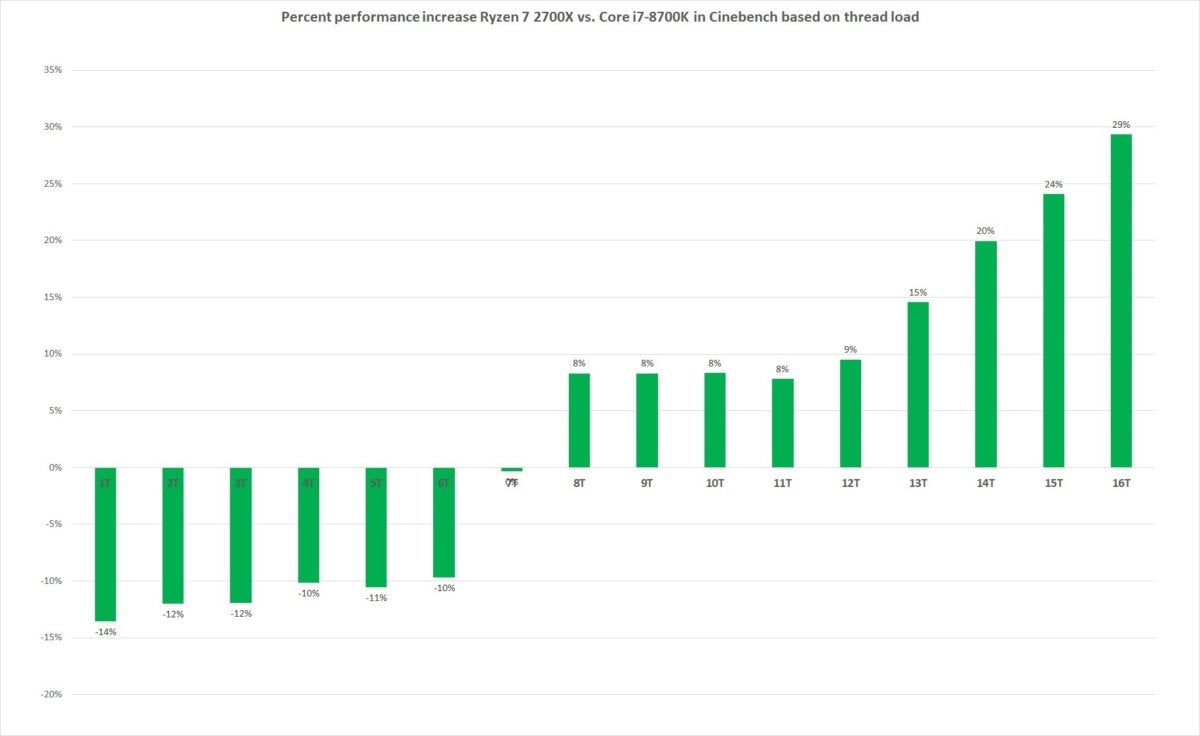 IDG
IDG In its day, the 2700X was even as revolutionary for its price-to-performance ratio—especially American Samoa you moved into high-altitude Congress of Racial Equality count workloads. Its primary adversary was Intel's 6-core Core i7-8700K. The Ryzen 7 2700X dismantled the Core i7-8700K on the honorable face of the chart, where you used all of those CPU cores. On the left side of the chart, indicating performance on fewer cores, IT was largely underwater against its the Intel chip.
Wind the time forward to July 2019, and you see below the equal face-of betwixt the 12-nucleus Ryzen 9 3900X and its coeval—Intel's 8-core Kernel i9-9900K. You can immediately see that AMD ready-made big strides with the Zen 2 meat. The Ryzen 9 3900X is basically breathless-even to slenderly faster than the Core i9-9900K, and it dominates as you get in the heavier all-core loads.
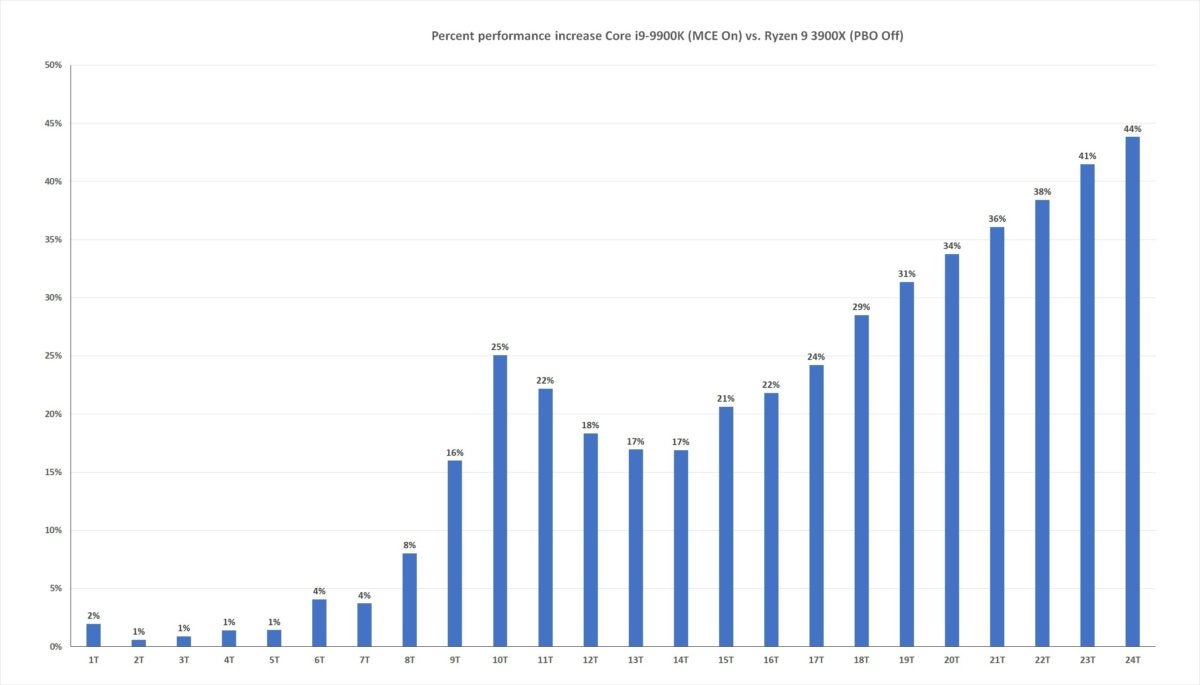 IDG
IDG That brings us to today, with where we have the 12-meat Ryzen 9 5900Xand perform the assonant mental testing with its current—the 10-substance Core i9-10900K. It's that left side of the chart that we really privation to point out. The Zen 3-based Ryzen 9 5900X posts an 18-percent advantage in individualist-threaded functioning. From there it only goes upward, showing mostly 20 to 30 percent many carrying out from the Ryzen 9 5900X compared to the Core i9. IT doesn't matter if IT's a light load or heavy load–Ryzen simply crushes the Core i9.
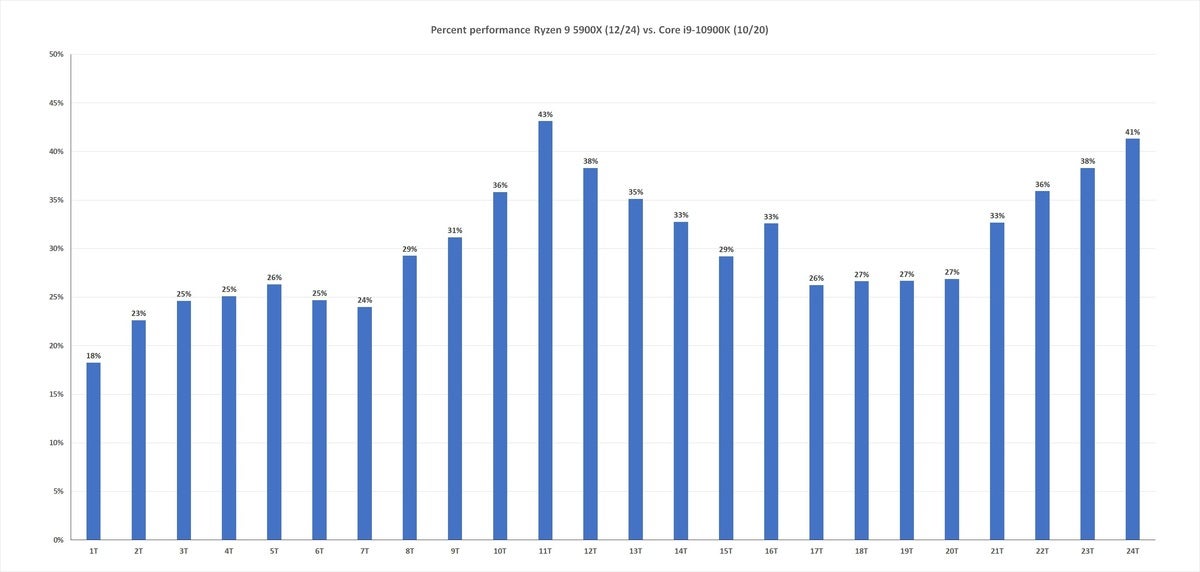 IDG
IDG AMD fans may constitute a trifle disappointed the Ryzen 9 5900X "exclusively" has a 41-percentage vantage when every core is stressed out, merely the Ryzen 9 5900X isn't the top-end Ryzen 9. We did the indistinguishable prove using the 16-core Ryzen 9 5950X, and you can experience an even higher 22-percent advantage on a single-thread, extending out to an obscene 71-percent lead when complete togs and cores are used.
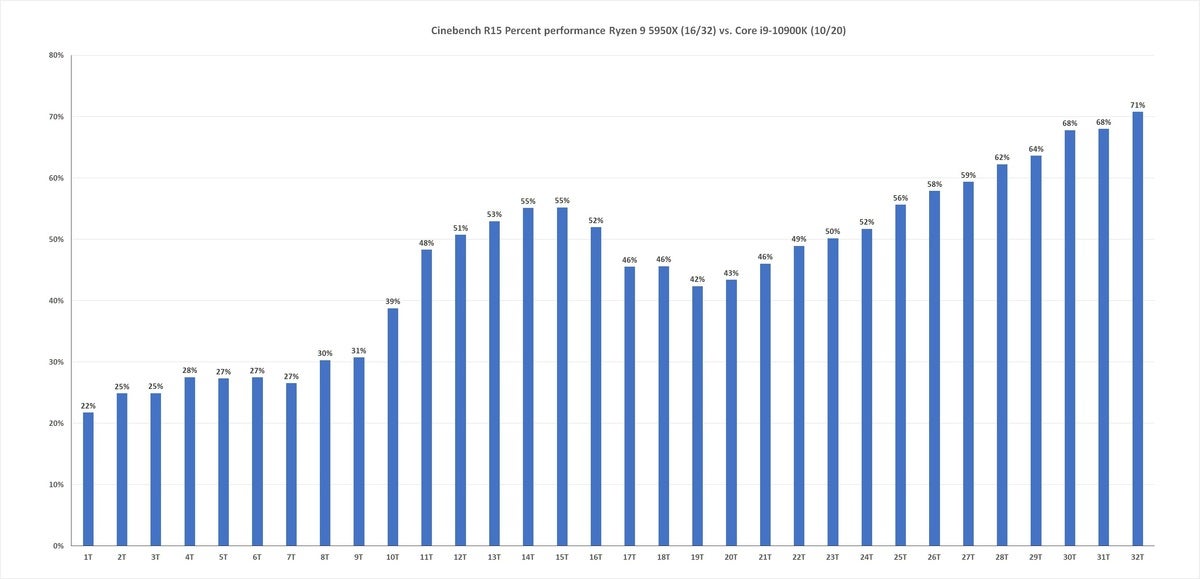 IDG
IDG You Crataegus oxycantha say it's non bonny to put an $800 Ryzen 9 5950X against a $488 Core i9-10900K. Normally we'd agree, but for much of the year, the Congress of Racial Equality i9-10900K was in such sawed-off add that information technology regularly oversubscribed for $650 and higher. In fact, as of October 30, the street price of the Core i9-10900K was healthy in a higher place its expected retail price at most stores.
Pricing has been extraordinary charge since AMD unveiled its Zen 3 chips. So, the stupidly good value that AMD has offered previously has gotten less stupid. To present that visually, we look at the expected retail cost of current CPUs and calculate how much the society charges per string.
This is an overly simplistic look at CPU pricing, but it does give you an easy direction to visualize how they compare. Boilers suit, the four new Ryzen 5000 chips have increased in price over previous models, likely because AMD knows information technology can finally charge premium pricing for the chips.
It doesn't assistance that Intel's CPUs generally haven't been a great time value, and they tend to sell well above their tilt prices on the street. On the chart below, you can see a few spot-checks on current AMD chips and Intel chips. A greens highlight indicates they're selling at or below the heel price, while red is selling above its lean price.
So yes, there's been a definite price hike. But with the carrying into action we're seeing, we think it's wholly justified, especially when you consider that Intel CPUs continue to be the premium-priced chip despite not offer the premium performance.
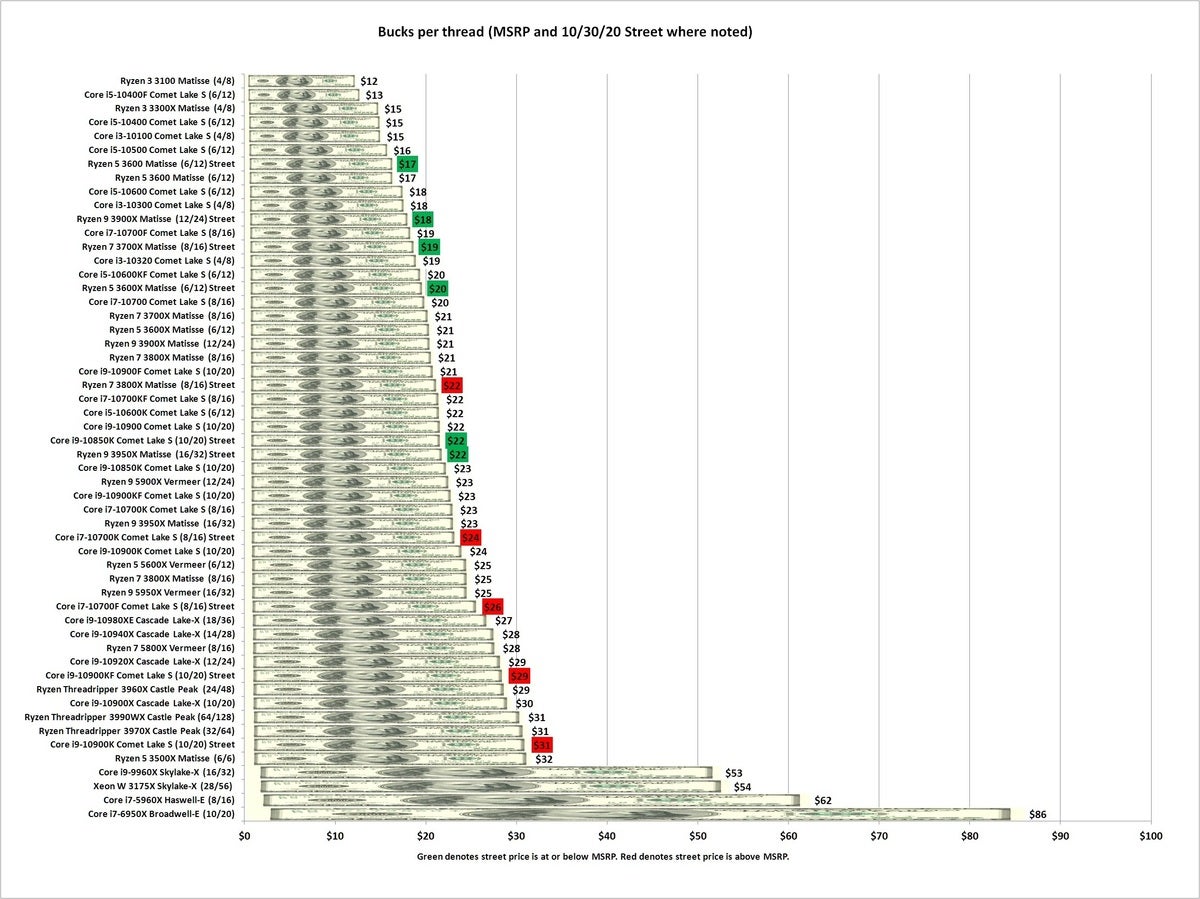 IDG
IDG Conclusion
It's hard to beryllium believe, but it's been only three years since the unconventional Zen-based Ryzen CPUs were introduced. The germinal Ryzen reset our expectations of how many cores you could pull in a consumer CPU, and it put the world on notice that AMD was back.
With the Ryzen 5000 we'ray just floored away its carrying out. It's the best CPU for heavy multi-core loads. It's the incomparable CPU for idiosyncratic-core loads. It's the best CPU for gambling. Add thereto support for PCIe 4.0, compatibility with galore existing AM4 motherboards, and actually reasonable prices, and you get what is without doubt the best CPU we've ever seen.
 Gordon Mah Ung
Gordon Mah Ung Source: https://www.pcworld.com/article/393664/ryzen-5000-review.html
Posted by: lewisyedis1951.blogspot.com

0 Response to "AMD Ryzen 5000 Review: The best consumer CPU we've ever seen - lewisyedis1951"
Post a Comment